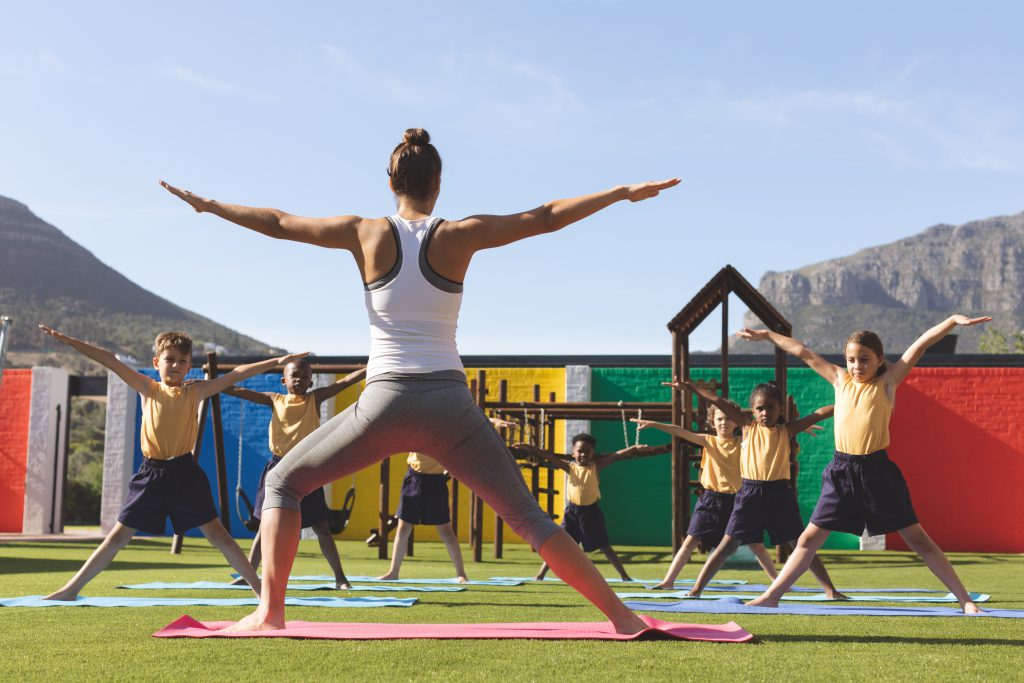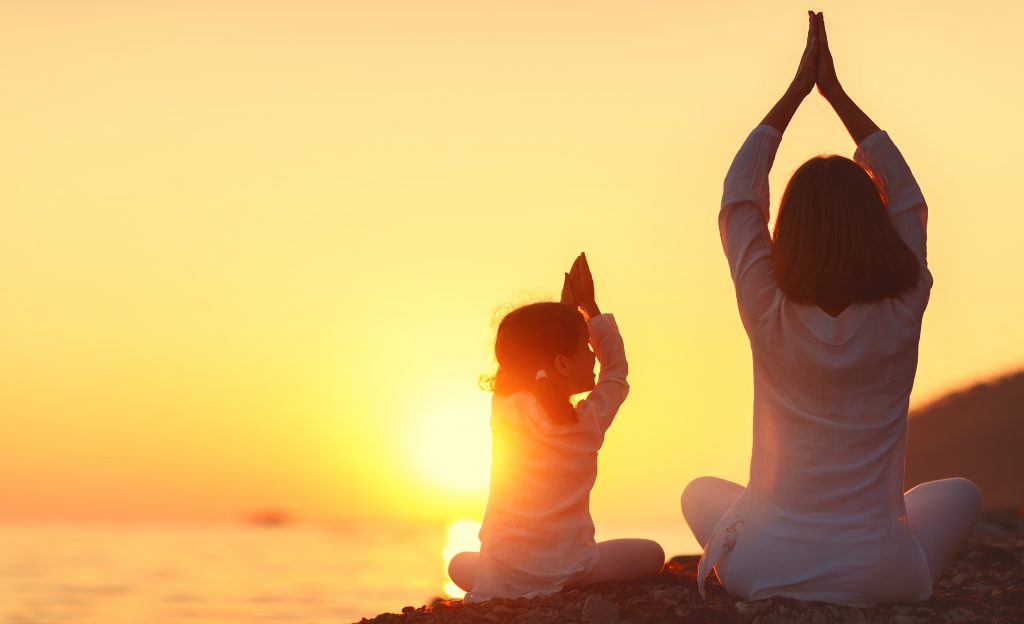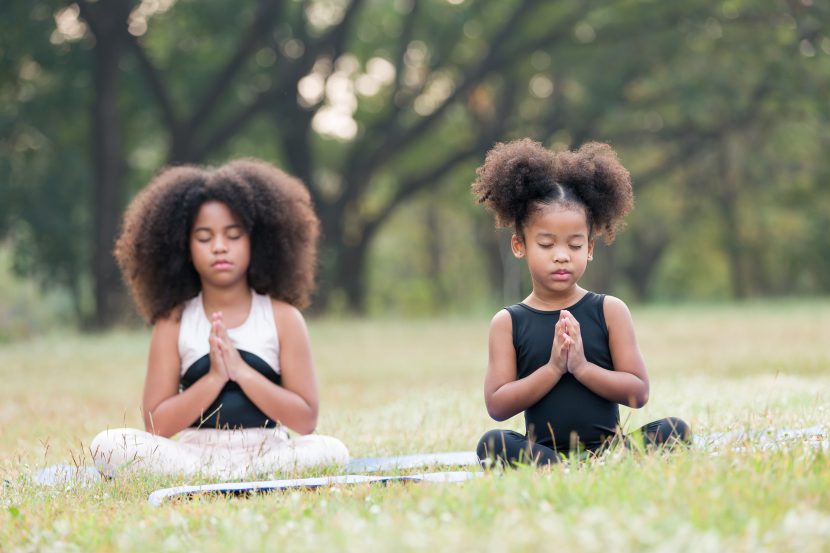Just like adults, children’s ability to relax has a significant impact on their cognitive and metacognitive development. This state of balance is not an innate skill, but instead can be learned through regular practice and exercise. By engaging in relaxation techniques such as yoga, children can improve their mental state which, in turn, enables them to cope with stress in a healthy manner. It is safe to conclude that children’s well-being is in direct correlation with the quality of their thoughts and resources for a healthy and prosperous childhood.
Comparing yoga to physical exercise
The practice of yoga heavily relies on physical exercises and breathing techniques. Contrary to the popular belief, anyone can do yoga, children and seniors alike. There are several yoga postures that make up the basis of every practice, with numerous variations that can suit anyone.
The main difference between yoga and sports is that the practitioners are encouraged to move slowly through the poses, focusing on the breath. The main focus is on gentle stretches that relax the body on a deeper level. Mindfulness and emotional regulation are profoundly embedded in the practice and serve as a tool to achieve relaxation through strengthening the mind. (Couturier K, n.d.)
Yoga for children has become a popular concept over the past couple of years. Yoga teachers draw inspiration from ancient yoga philosophy to pass the knowledge to the youngest students. Children engage in fun and playful physical exercises in small groups, listening to instructions from the teacher. They also get to hear stories that help build compassion and empathy throughout the practice. By practicing yoga on regular basis, children can improve their posture, and flexibility, but also enhance their memory and overall mood.
According to Shana Meyerson, a yoga studio founder, “the child’s yoga practice is a rare opportunity for children to experience play and focus without worrying about being wrong.” (Tilak V, 2014) Similar to physical education classes, children have a chance to release tension and purposefully relax the muscles when doing yoga. In order to achieve a state of calmness, children include both elements of leisure and activity. As a result, most students refine balance and coordination skills, as well as overall confidence and self-esteem. (Tilak V, 2014)
Physical, cognitive, and emotional benefits for children
“A growing body of research has already shown that yoga can improve focus, memory, self-esteem, academic performance, and classroom behavior, and can even reduce anxiety and stress in children.”
– Wei M, 2016
Therefore, it comes as no surprise that there’s an ever-increasing number of yoga practitioners among school children. By practicing yoga postures, students get to build endurance and patience. Learning through play helps children to actively engage in activities and connect the experience of acquiring knowledge with feelings of joy. As the end result, these children learn to perceive the world around them as a safe and caring place. (Wei M, 2016)

Practicing mindfulness helps children to stay in the present moment, fully aware of their inner state and outer surroundings. They are able to adapt better and react with more compassion and understanding. By engaging in meditative practices on regular basis, children are able to revise their patterns and adjust their behavior. They are invited to observe the feelings that surface, rather than react in a defensive manner.
According to the American professor of medicine, John Kabat-Zinn, “this condition of ‘mindlessness may contribute to improving health and psychological outcomes linked to anxiety, depression, emotion dysregulation and negative mood.” (Cunsolo S, 2021) It was proven that just like other successful methods such as imagination, music, or game-based relaxation techniques, yoga too has a significant positive influence on stress reduction and emotional balance.
The effects of school-based yoga
Many schools around the world embraced yoga classes in the last decade. However, some parents argue that yoga might negatively influence their children, as there are sometimes prayers and chanting involved. They don’t want the students to practice yoga in an open space, and follow certain religious cults, as some like to call them.
This is precisely why teachers don’t indoctrinate their students. Both physical and mental aspect of yoga practice has proven to boost the mind-body connection, which is an incredibly valuable resource to have at their age. (Tilak V, 2014)
Based on an eight-weeks-long, controlled and a school-based study conducted in 2016, teachers and staff reported a positive influence of yoga exercises, backed up by the experimental group’s results. It has been concluded that practicing yoga can help students with anxiety.
It also positively impacted students who felt stressed for various reasons in the school environment. By helping children to face the challenges early in the process, we are setting them up for success. Prolonged stress can lead to health issues, anxiety disorders, and even depression. (Bazzano A, 2018)
Teachers in US classrooms regularly partner with psychologists and local organizations to help students regulate their emotional responses and improve their behavior. Mindfulness yoga programs as short as ten weeks have had a significant influence on primary school students.
Back in 2017, one such trial was conducted in New Orleans, where yoga teachers provided professional guidance to pupils. The results have unanimously shown that “the students’ psychosocial and emotional scores increased.” (Bazzano A, 2018)
Encouraging yoga for children in the future
Every child has the right to develop to their fullest potential. Parents and educators have the power to help them create strong willpower and vigor through successful methods of stress alleviation. Music, imagination, and yoga have proven to be great ways for little ones to work on their physical and mental strengths. Proved that the other conditions are fulfilled and their basic needs are met, all children can reap the fruits of yoga regardless of their age, experience, or status.

If you too care for children and want to help us realize their rights, please consider donating, becoming a volunteer, or sponsoring one of the children. We appreciate every little bit of support!
Written by Lidija Misic
Bibliography:
Bazzano et al. (2018). Effect of mindfulness and yoga on quality of life for elementary school students and teachers: results of a randomized controlled school-based study. Retrieved from National Library of Medicine at https://www.ncbi.nlm.nih.gov/pmc/articles/PMC5903833/, accessed on October 23, 2022.
Couturier Kelly (n.d.). Yoga for Everyone. Retrieved from New York Times at https://www.nytimes.com/guides/well/beginner-yoga, accessed on October 22, 2022.
Cunsolo et al. (2021). How relaxing develops and affects well-being throughout childhood. Retrieved from UNICEF at https://www.unicef-irc.org/publications/pdf/how-relaxing-develops-and-affects-well-being-throughout-childhood.html.pdf, accessed on October 23, 2022.
Tilak Visi (2014). The Benefits of Yoga for Kids. Retrieved from Parents at https://www.parents.com/fun/sports/exercise/the-benefits-of-yoga-for-kids/, accessed on October 22, 2022.
Wei Marlynn (2016). More than just a game: Yoga for school-age children. Retrieved from Harvard Health Publishing at https://www.health.harvard.edu/blog/more-than-just-a-game-yoga-for-school-age-children-201601299055#:~:text=Yoga%20and%20mindfulness%20offer%20psychological,anxiety%20and%20stress%20in%20children, accessed on October 23, 2022.


